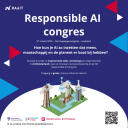Amsterdam University of Applied Sciences

Activity
- 241Updates
- 0Thumbs up
- 50Comments
Jorgen Karskens,
Project manager Civic Interaction Design
at Amsterdam University of Applied Sciences,
posted
Liza Verheijke,
Community Manager
at Amsterdam University of Applied Sciences,
posted
Jorgen Karskens,
Project manager Civic Interaction Design
at Amsterdam University of Applied Sciences,
posted
Leontine Born,
Programme Manager Learning Community 'AI & public services'
at Amsterdam University of Applied Sciences,
posted
Liza Verheijke,
Community Manager
at Amsterdam University of Applied Sciences,
posted
Jorgen Karskens,
Project manager Civic Interaction Design
at Amsterdam University of Applied Sciences,
posted
Marije Poel,
Programma manager
at Amsterdam University of Applied Sciences,
posted
Jorgen Karskens,
Project manager Civic Interaction Design
at Amsterdam University of Applied Sciences,
posted








